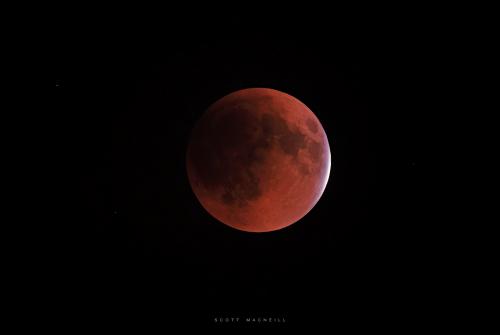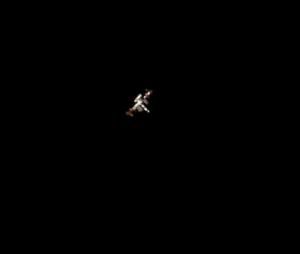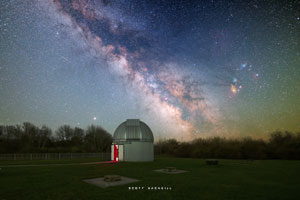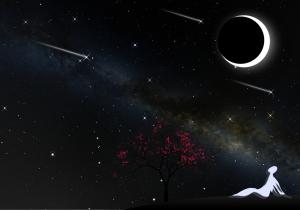Celebration of Space - May 20, 2022

The moment that the total eclipse stage started during the Flower Moon Eclipse of Sunday, May 15, 2022. Credit: Frosty Drew Astronomy Team member, Scott MacNeill
On Sunday – Monday, May 15 – 16, 2022, a stunning total lunar eclipse occurred over much of North America, with New England falling into one of the best regions to view the event. Unfortunately, fog and clouds obscured the view for many people around the Southern New England region, though depending on where you were, you could have seen specific stages of the eclipse, while others could not. At Frosty Drew Observatory and Science Center, we were located at one of the worst locations regarding weather, being that we are right on the RI south coast about one mile from the water. So Frosty Drew Astronomy Team members decided to set out to different locations across Southern New England in an attempt to capture the eclipse. Overall, we were able to capture a full data set of the event, though fog and clouds certainly factored in. When digging through images of the event, we were able to recover most of the eclipse, even in images that were heavily affected by fog. Take a moment to bowse our gallery of images of the eclipse. We will be adding images over the next few days to create a full set. So periodically check in. The next total lunar eclipse happening over our region will occur on Tuesday, November 8, 2022 during the morning hours.
Fantastic evening passes of the International Space Station (ISS) continue this weekend and next week, offering up moments of amazement for those under clearer sky conditions. Overnight passes will continue for a few nights, but will start to wane into just the evening hours as the week progresses. Here are a few notable passes of the ISS for the next several nights:
Fri, May 20 at 9:11 pm, starting in the WNW, rising to 17°, heading towards the NNE
Sat, May 21 at 10:01 pm, starting in the NNW, rising to 14°, heading towards the NE
Sat, May 21 at 11:37 pm, starting in the NW, rising to 24°, and into orbital sunset
Sun, May 22 at 9:12 pm, starting in the NW, rising to 14°, heading towards the NNE
Sun, May 22 at 10:49 pm, starting in the NNW, rising to 20°, and into orbital sunset.
Mon, May 23 at 10:01 pm, starting in the NNE, rising to 17°, heading towards the NE
Tue, May 24 at 10:50 om, starting in the NW, rising to 35°, and into orbital sunset
Wed, May 25 at 10:02 pm, starting in the NW, rising to 25°, heading towards the ENE and into orbital sunset
Thu, May 26 at 10:50 pm, starting in the NW, rising to 53°, and into orbital sunset
Orbital sunset occurs when the station orbits into Earth’s shadow. During this time, residents of the station will experience sunset. When viewing the ISS, or other satellites, the viewer needs to be in nighttime while the satellite is in direct sunlight. All we see down here is just sunlight reflecting off of the satellite. Note that the passes above are applicable to Southern New England, and are generally acceptable for the entire Northeast. For daily pass times of the ISS and other satellites, check in every day on the Frosty Drew Daily Satellite Pass Prediction Utility.
Now that the Moon has passed the full phase, and is beginning to depart the night sky, Milky Way viewing is back in gear. At Frosty Drew Observatory and Science Center, the Milky Way starts to become strikingly visible just after 1:00 am, during this time of the year, on nights without the Moon and without clouds. Due to the early morning time frame, we do not host any Celebrate the Milky Way special events in May, and are even a bit reserved about doing them in June. Though the view is still accessible for anybody willing to cruise out to the southern coastal locations in Charlestown, Rhode Island. Our Celebrate the Milky Way special events are events scheduled on the Saturday nights that we think will bring the best views of the Milky Way to our location during the summer season. One of the big draws to Frosty Drew is that we have such a spectacular view of the Milky Way from our location, and it’s a view that is easy to get to. Meaning that in other areas of New England that may have a better view, you will likely have to hike out, climb, or spend the night searching for a clearing to actually see it. At Frosty Drew we have a roadway right into our location, a wide open view of the sky, and an astronomical observatory on site. If seeing the Milky Way stretch across the sky is on your bucket list of things to do in life, then now is the time to start planning your view as Milky Way viewing season is now in full swing! Visit our events calendar for a listing of Celebrate the Milky Way events coming this summer.
Next Friday, May 27, 2022, we kick off our Summer Stargazing Nights events. These events are similar to our regular Stargazing Nights events, though they will bring more telescopes, more astronomers, additional presentation stations, and the return of our summer solar viewing sessions. Starting every Friday at 6:30 pm, the Frosty Drew Observatory Courtyard will have two or more solar telescopes set up offering safe views of different atmospheres of the Sun. Being that Solar Minimum is officially over, and activity on the Sun has been increasing very quickly and dramatically, this summer will bring spectacular views of sunspots, prominence, solar filaments, and intense magnetic field lines, all available for viewing! We will also be introducing two new stations this summer. The first station is Under the Willow, which will bring story time on the waterfront underneath the large willow behind the Science Center on the hour three times every Friday night. The second new introduction will be a live stack view from a telescope of specific deep sky celestial objects. Live stacking means that the object in the telescope will be presented on a screen with continual data collection. The longer we view the object, the brighter and more detailed the image will be on the screen. This station will be presented at the Lunar Lounge on nights that the Moon is not visible. As the summer continues, we will re-introduce the Meade LX200 16 inch telescope, which used to be in the observatory dome, as a new station. We will also be introducing a night tour to Spaceport Rhode Island, which is about 300 meters to the NW of our location, and is the site of the Project Comet Chaser rocket’s launch into space. Project Comet Chaser now resides in the Frosty Drew Science Center as an exhibit. So make plans to visit Frosty Drew Observatory and Science Center this summer, and set your inner geek free!
- Author:
- Scott MacNeill
- Entry Date:
- May 20, 2022
- Published Under:
- Scott MacNeill's Columns




